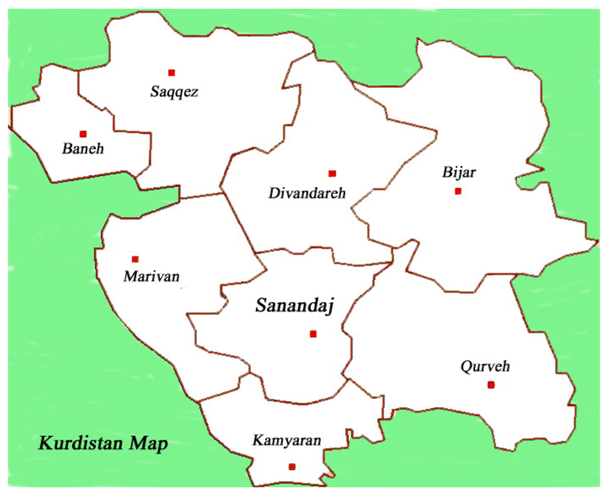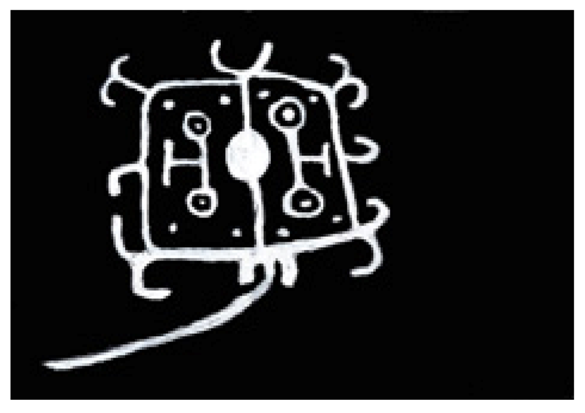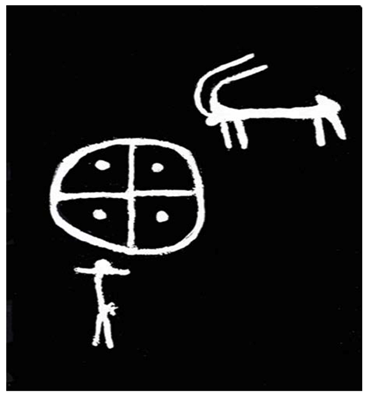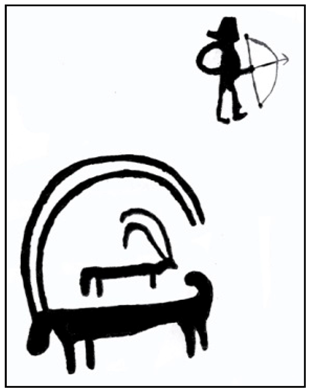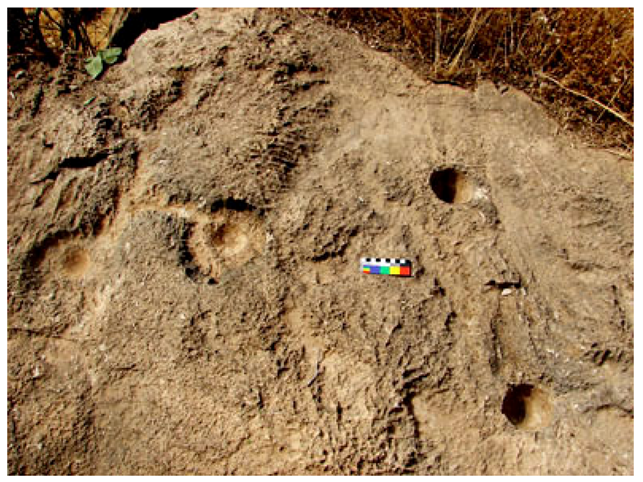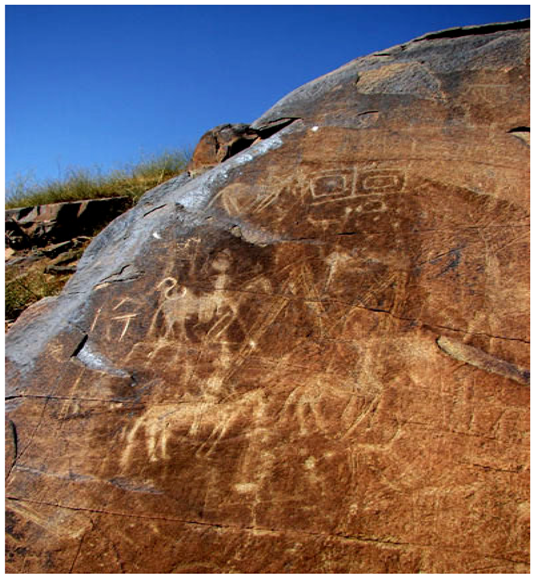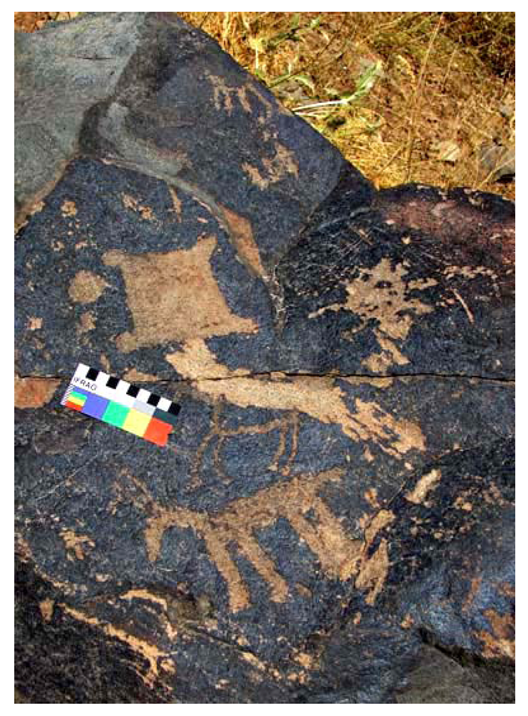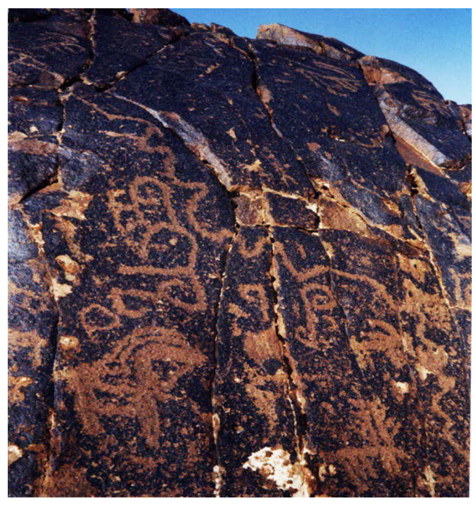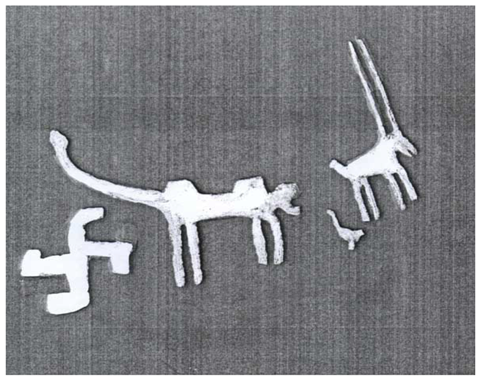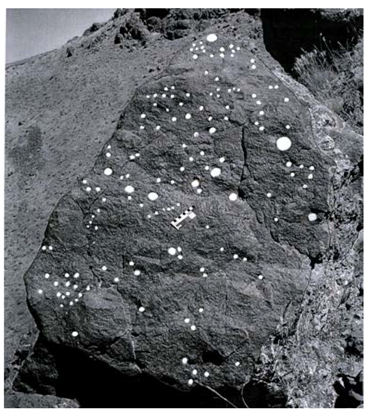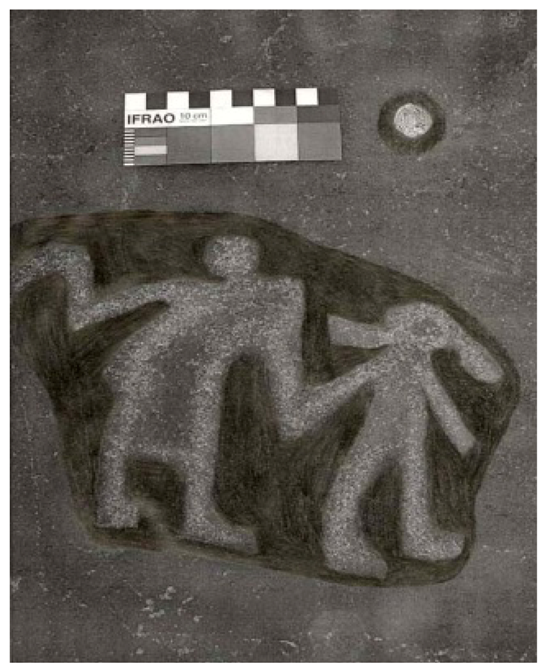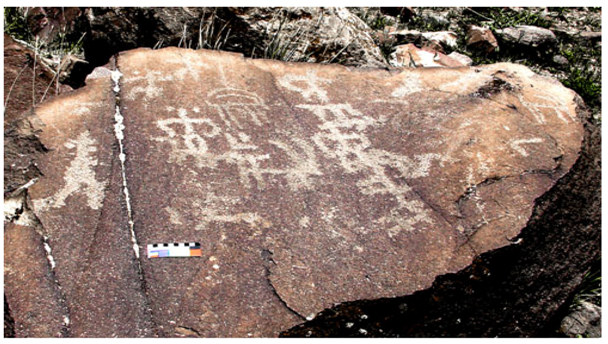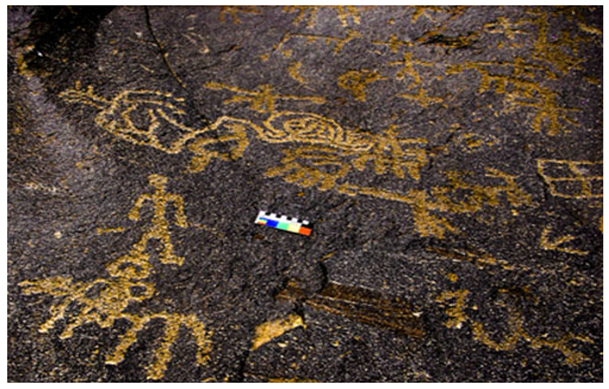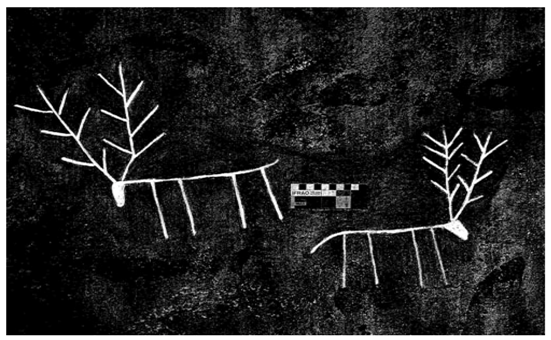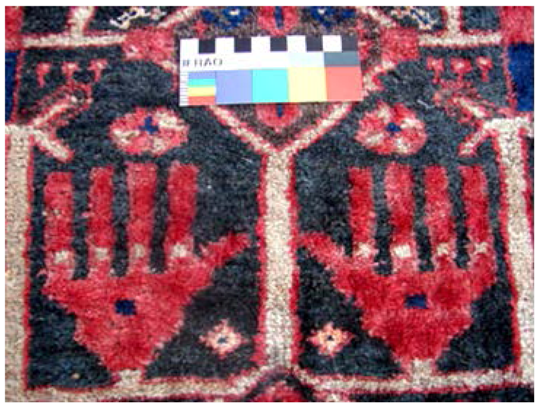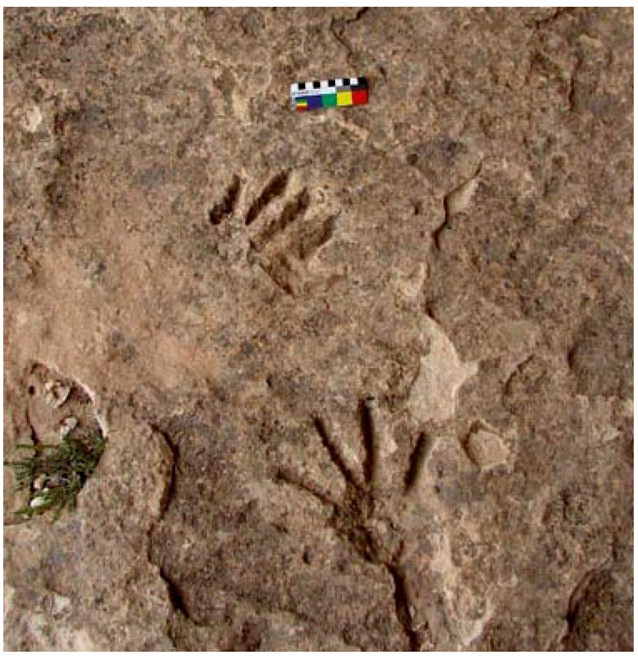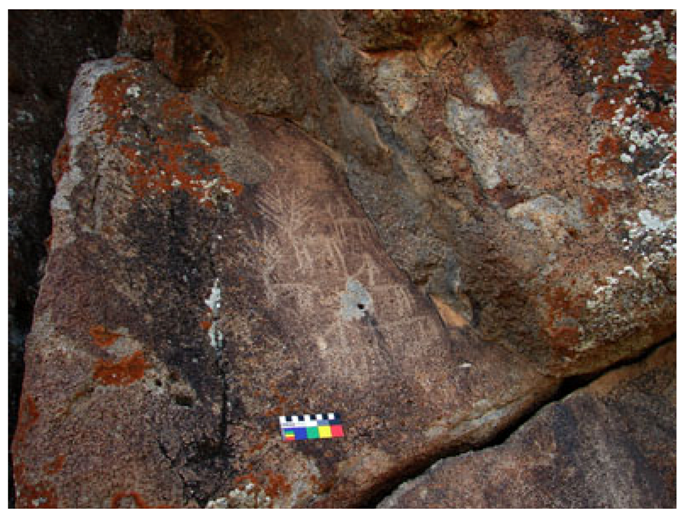3.4. The Rock Art of Tash Cave
At the end of the ancient village, in the west of the valley, there is a huge stone, under which can be found the Tash Cave. The height of the inside of the cave is 2 m and its diameter is 4 m. The interior situation of the cave and the entrance, on the left, shows that it was in used in the prehistoric era. On the outer wall of the cave, 3 m higher than the surrounding land to the east, there are some petroglyphs consisting of three “horses with riders”, one of them is holding something in his hand. They are moving to the north in a row. There are also three depictions of “ibexes” shown under the riders that with regard to patination seem to be older than the other petroglyphs. Similar images of “ibexes” and “horse riders” also exist, which based on the patination, are probably recent of age. Tash Cave is one of the prehistoric settlements of Hawraman. The pattern of ibexes in the caves of Bardmir and Martash is older than the horses and riders patterns [
2]. In addition, several “ibexes” are engraved on a boulder located on a vertical wall 100 m to the west of Tash Cave.
Figure 2.
Hawraman, Bendoul, Havar-Sivieh, Rangavarzhilah rock, geometric marking with dimensions of 90 cm by 106 cm.
Figure 2.
Hawraman, Bendoul, Havar-Sivieh, Rangavarzhilah rock, geometric marking with dimensions of 90 cm by 106 cm.
On the way to the ancient village, 300 m northwest of the cave, are around 10 cupules with 2 to 5 cm in diameter and maximum 2 cm of depth, on a limestone boulder. Within 5 m west of this limestone, there is a mortar with 20 cm depth and diameters [
7].
My efforts have resulted in discovering several collections of cupules in the region, which seem to belong to different periods [
7,
8,
13]. Cupules in Kurdistan, particularly in the Hawaran region, where a great number of cupules are identified, usually occur on hillsides, plains, bank of the rivers, old springs and inside the caves [
7]. These cupules have not been the results of natural agents like water, plants and minerals, but they are products of the creativity of the mind and man-made during thousands years, manifestation found in different parts of the world [
14].
3.6. The Petroglyphs of Soren in Kousalan
The petroglyphs of Soren are located in the southwest heights of Kousalan, 1550 m above sea level and 4 m above the surrounding area to the south of Souren. This site was identified in summer 1999 [
2,
3] (
Figure 5). Human and animal depictions, an archer with a hat on his head and 18 cm in height are the most important petroglyphs of the site. There are also images of “antelopes”. The bigger one with horns drawn to the tail is 24 cm and is engraved on the back of small one with 9 by 9 cm dimensions (
Figure 5). This depiction is comparable with “ibex” in rock art of Bayenchou and Srawghamesh area in Kurdistan and so is comparable with Koul Zhabasi petroglyph in Kazakhstan [
16]. Below of these petroglyphs, there are seven “antelopes”, two tuskers and other figures, which are not recognizable due to erosion. Within 200 m of east of Souren petroglyph, there is the Asb Cave (Mar-asb), facing toward the west.
Figure 5.
Kousalan, “ibexes” and Souren petroglyphs.
Figure 5.
Kousalan, “ibexes” and Souren petroglyphs.
3.7. The Rock Art of the Village of Dala-Marz
The village of Dala-Marz is located in 90 km of Marivan. Ten rock shelters made of limestone are located 1 km south of the village, 2200 m above sea level and 400 m from Sirwan river.
3.7.1. The Cupules and Mortars of Asl-Gah
Asl-Gah rock shelter is one the oldest settlements of Hawraman and its mortars and cupules belong to prehistory. In one of the rock shelters a cupules is identified next to seven mortars whose diameters range from 7 cm to 18 cm. Seven of them are next to each other and one of them is a little further. In other refuges, there are more single cupules and mortars.
3.7.2. Mortars and Cupules of Zardou Mara Rock Shelter
Zardou Mara rock shelter is located northwest of Dala Marz village and around 500 m from the Sirwan river. There is a long limestone wall to the east. The refuge is 4 m higher than the surrounding lands and there are seven mortars and one cupule on its surface, three of them are alone and four of them are together. Their diameters ranges from 7–10 cm. Besides them, on the steep peak of the boulder, there are cupules with 8 cm diameters and 1 cm depth. The Hana-Mari rock shelter is also located in this area and has individual cupules.
3.7.3. Cupules, Mortars and Human Depictions in Shemiran Cave
The Shemiran cave is located 2 km southwest of Dala Marz village at 1700 m elevation above sea level, and its entrance is 15 m higher than the surrounding area. About 20 m from this cave there is a spring whose water is pumped to the neighboring village. This cave has 15 m in length and 10 m in width and an approximate height of 15 m. Remaining ruins of a rectangular room on its floor with 3 m in depth, 6 m in length and 3 m in width is seen. The carving out of the room and its stone wall needed a metal axe and the remnants of axe-traces can be seen on the vertical surface. The black color of the southern corner of the room shows the presence of fires in the past, in the middle of the same wall on engraved half body (face) of a human is seen. A circle shows the head and some lines show the shoulders. Half of the face, like eyebrows, eye, nose and right cheek are clearly engraved. There is a mortar with 10 cm diameter and two individual cupules on the natural surface of the cave.
3.7.4. Rock Shapes and Mortars in Two Areas (Dowlou Lakala) of Dala Marz Village
On the way to the Doul area, there are two mortars; the diameters and depth of one of them is 25 cm and they were used for grinding grains. At a 5 m distance from them, on the horizontal surface of a boulder of 170 cm, an oval mortar with 50 cm length can be seen, which was probably used for grinding grains. On the vertical surfaces of boulders that have formed, like the pillars of ruined rooms of the area, shapes such as pictures of humans and animals are seen (
Figure 6).
Figure 6.
Hawraman, Dala Marz village, Doul-Havar, a “scene” including anthropomorphs, zoomorphs and a human shape holding an arrow in the bow with stretched arms.
Figure 6.
Hawraman, Dala Marz village, Doul-Havar, a “scene” including anthropomorphs, zoomorphs and a human shape holding an arrow in the bow with stretched arms.
3.10. The Rock Art of Palangan Village
Palangan village is located in 50 km west of Kamyaran, around 1 km north of this valley and 200 m of Sirwan river. In a place called Sarban, five mortars and two cupules are engraved on the horizontal surface of four boulders. On the horizontal surface of one of the boulders, two mortars of 10 cm diameter and two cupules of 4 cm in diameter have been engraved (
Figure 7). Three other mortars with 10 cm in diameter are carved individually on the horizontal surface of three other boulders. Some 3 km west of Palangan village in the heights above the Sirwan river, on the surface of boulders, footprints of humans have been carved. About 200 m south of the village, and north of the Sirwan river way, on the horizontal surface of a boulder, four oval mortars and a conical mortar are located. About 5 km west of Palangan village, and on the Sirwan river way to Devaznaw, there are oval mortars that are famous as “Gabr footprints”.
Figure 7.
Hawramn, Palangan village, two mortars with 10 cm diameters on the right and two cupules on the left with 4 cm diameter and cup and ring marks, which are connected with a groove.
Figure 7.
Hawramn, Palangan village, two mortars with 10 cm diameters on the right and two cupules on the left with 4 cm diameter and cup and ring marks, which are connected with a groove.
At a distance of 2 km southwest of these mortars there is a cave called Kolo Mari, with an approximate height of 7 m and a depth of 19 m, facing north, containing a mortar. On the vertical surface of the western wall, two single figures have been engraved. The figure of an animal, probably a horse, and the figure of human raising the hands, with some parts of its hands destroyed.
3.11. Saral Region Rock Art
A large portion of the petroglyphs of Iranian Kurdistan is located in Saral. Some of the petroglyph motifs in the Saral region cannot be observed in any other parts of Iranian Kurdistan; they are masterpieces among the rock arts of the province.
The drawings include motifs that seem to depict horses and riders, deer with different types of antlers, elk, women and men that maybe dressed or naked, wolves, foxes, rabbits, camels, hunting dogs, leopard, boars, snakes, trees, other plants, and geometric shapes such as circle with a smaller one in the center of that square they have depicted rectangle and diamond. Antelopes are extinct in the Saral mountains but according to the statements of the witnesses like the elderly of the region, there were big herds of antelopes in the mountains and plains of this region forty years ago. It seems that there have been herds of deer, elks and antelopes in earlier. More of engraved drawings on the rocks in Saral region are available during the periods that still have flowing creeks. Saral pastures are still a good place for settling the herdsmen [
2].
3.14. Kouchekcharmeg Village Petroglyph
There are several rock art sites in the valleys and heights of this village. One of the areas is located in Shajou Mountain, Kani Reihan, in a place called Kal Ba. There are a lot of images on the surface of these outspread boulders with different dimensions, which were probably created during two periods. The area where these images have been created was a good place for those hunters who were chasing antelope, deer, and elk with their fast horses in the low plains [
2] (
Figure 8 and
Figure 9).
Figure 8.
Saral, Kouchekcharmeg village, Sha Jou Mountain, “horse riders” “hunting”.
Figure 8.
Saral, Kouchekcharmeg village, Sha Jou Mountain, “horse riders” “hunting”.
Figure 9.
Saral, Kouchekcharmeg village, Sha Jou Mountain, zoomorphs, geometric markings on a single boulder.
Figure 9.
Saral, Kouchekcharmeg village, Sha Jou Mountain, zoomorphs, geometric markings on a single boulder.
The biggest boulder bears images vertically facing east and has the most motifs of this site (
Figure 8). Images like “antelope”, “elk”, “gazelle”, “ibex”, “hog”, “human” images in different attitudes, a “horse and its rider” and geometric markings can be seen here. In the middle of the boulder, there is an “elk” of 47 cm in height [
2] (
Figure 8). The biggest image of this boulder is a “running human” of 50 cm in height. According to historical texts, horses were very common in ancient times and were one of the taxes that the Maad paid to Assyrians. Kurdistan horses are from Nesaei race. The horse is used in a very limited way in Kurdistan now. A picture of a small animal, probably a dog, has been engraved on the top of other images (
Figure 9).
3.15. Petroglyphs in Bayenchou Village
There is a row of boulders 1 km southwest of Bayenchou village in the northern hillside of Sakhnakh Mountain, bearing petroglyphs on horizontal and vertical surfaces. This area is known as Shah Abbasi to people of the village. There are images of five animals, probably horses, which are drawn on a big boulder to the north, 4 m higher than the surrounding lands, with approximate dimensions of 12 to 29 cm. There is a circle between the third and the fourth horse, another geometric image like a rectangle is engraved between the legs of the third horse (Lahafian 2004:
Figure 8) [
2]. On the top of these figures, another image of an engraved “horse” is fading. “Antelope” images have been carved of the left side of this region. There are also images of “rabbits”, horned animals and a long-necked animal and “human” images with “arrow and bow” and circle and square symbols in this area. Bayenchou village valleys and Kouchek Charmeg have excellent petroglyphs (
Figure 6,
Figure 10 and
Figure 11 and the photo on the cover in Lahafian 2004) [
2]. Saral artists of Kurdistan have created a sample of graphic, animated, perspectival, abstract images and geometric patterns style. They have exhibited panels with antelope images, which is a common motif in the rock art of Iran, zoomorphs, probably leopard or lion and abstract motifs circle like dots and ‘snake’ images (
Figure 10 and
Figure 11).
Figure 10.
Saral, valleys of Kouchekcharmeg village on the vertical surface of a boulder, big spiral images, “antelope”, “deer”, and other motifs.
Figure 10.
Saral, valleys of Kouchekcharmeg village on the vertical surface of a boulder, big spiral images, “antelope”, “deer”, and other motifs.
Figure 11.
Saral, valley of Bayenchou village, depictions of a swastika and three zoomorphs.
Figure 11.
Saral, valley of Bayenchou village, depictions of a swastika and three zoomorphs.
3.16. Cupules and Petroglyphs in Afrasiaw Village
About 1 km west of Afrasiaw village in a valley called Pesht Tang on the steep surface of a 14 m boulder to the south, tens of cupules with different dimensions from 1 to 7 cm have been hammered. Some form circular patterns, some are paired or in linear groups. There is a cupule with 5 cm diameter on the boulder’s peak. On the left side of the bottom of the boulder six small circle-like couples with 2 cm in diameter have been carved. In the middle of the circle, there is a cupule that has been created on this boulder as a line (
Figure 12).
Figure 12.
The cupules of Afrasiaw village, the order of these cupules in this boulder is thought to be deliberate. Some are engraved circle like and some in pairs or in line.
Figure 12.
The cupules of Afrasiaw village, the order of these cupules in this boulder is thought to be deliberate. Some are engraved circle like and some in pairs or in line.
About 10 m southwest of these cupules is a boulder of 3 m in height. Cupules have been carved on its vertical surface facing west as a line. On the top of the boulder, two anthropomorphs holding hands can be seen (
Figure 13). There is a cupule above their heads [
7].
Figure 13.
Saral, Afrasiw village, a pattern of two anthropomorphs.
Figure 13.
Saral, Afrasiw village, a pattern of two anthropomorphs.
3.18. Rock Art in Qorwa
Qorwa is a town in the west of Kurdistan. The Kal-Far rock art site is about 30 km northeast of Qorwa and 6 km northwest of Ghezljakand village, 1930 m above the sea level, and extends over about 1 km. Far away in the south, on the other side of the plain, the Bour and Parishan mountains across from the Kal Far site have created a beautiful view for the rock art of this area in Kurdistan. Great boulders have covered the area, and petroglyphs of humans and animals can be seen on them. These include purported depictions of antelope, ibex, horse and rider, camel, snake and other zoomorphs, human-like shapes and other graphic forms (
Figure 14). Unfortunately, shepherds and other local people have disfigured this rock art by writing their names over the petroglyphs. The rock art of this place was probably created during several periods (
Figure 15). In addition to these pictures, there are small cupules and ancient images of ‘ibex’ in this area that are fading.
Figure 14.
Qorwa, human-like images in different situations, dots and animals.
Figure 14.
Qorwa, human-like images in different situations, dots and animals.
Figure 15.
Qorwa, a big rock panel occurring on a steep surface and horizontal to the south, two periods are represented by anthropomorphs, zoomorphs and geometric patterns.
Figure 15.
Qorwa, a big rock panel occurring on a steep surface and horizontal to the south, two periods are represented by anthropomorphs, zoomorphs and geometric patterns.
There are cupules at most parts of the Kurdistan rock art sites. At Kal-Far, small cupules are seen individually or in groups. On a boulder of 1 m length and 70 cm height, there is a cluster of 23 cupules with 2 cm diameter and 1 cm depth. In addition, there are also another three cupules of a diameter and depth of 6 cm and 4 cm, respectively. On the steep surface of another boulder, facing south, there is a picture of a “human” putting his left hand on the waist, with three cupules. The diameter of one of the cupules is 8 cm and its depth is 3 cm. On the vertical wall of another boulder occur 13 cupules of 2 cm diameters. On the vertical surface of a boulder facing east, there is a line of cupules with animal and human depiction [
7].
3.19. Petroglyphs in Karaftou Cave
This site is located to the north of Divandareh and 74 km from Saqez. Based on geological studies, the rock at Karaftou is a folded Oligocene limestone with lines of disconformities in limited areas of Bijar and Divandareh [
9]. Karaftou Cave is located between the historic sites of Zivieh and Takht-e-Soleiman. The cave was discovered by an English doctor, G. Gormick, in 1819, and was at that time first described by Kerporter in 1822 [
19]. Rawlinson also visited it in 1838. One hundred years later, Estin completed its map in 1940. Rasoul Eshtoudan checked Karaftou Cave in 1994 [
20]. Other archaeologists have studied the site and its region during several phases [
21]. According to archaeologist’s statements, the existence of evidence inside and outside of the cave shows human usage of this cave during prehistoric times [
22]. The author went to Karaftou in 1999 for the first time after identifying rock art sites of Kurdistan, not because of its extraordinary architecture, but because of the rock art of different periods. Moreover, he had a lot of experience of other rock art in different areas of Kurdistan, which other explorers lacked. Rock images of this cave were studied and photographed frequently by the author [
2,
3,
4,
5,
6,
7,
8]. The main opening of the cave is 17 m high above the ground, which renders the use of a ladder necessary for access. In ancient periods, people have cut rooms, lobbies and doors inside the cave, forming four stories. The cave had thus been an impenetrable fortress in the past. The Karaftou region was one of the main centers of the Manna rule in the west of Iran, in the first millennium BCE. Only the patience of Median carvers could create such splendid architecture. So many rooms and lobbies cut into the heart of the mountain, arranged in various floors relating to each other, surprise any viewer. Without doubt, the type of hammer and chisel used by the carvers was made of iron. People living in this area feared the violent armies of the Assyrians, and presumably carved this castle into a natural cave. The Karaftou fortress has been used in different periods, which is apparent from architectural styles used in it as well as from petroglyphs on the walls. More recent traces also exist, including a Greek epigraph and an inscription related to the Islamic period. However, most of the petroglyphs in the cave belong to the building and people’s usage of the cave (
Figure 18). The motifs found in Karaftou Cave appear to depict horses and riders, men, wild goats, elks, camels, human hands, geometrical shapes and apparently symbolic images or signs and cupules (
Figure 16).
Figure 16.
Karaftou Cave, drawing of two cervids.
Figure 16.
Karaftou Cave, drawing of two cervids.
These images are present in most of the carved rooms into the rock. Unfortunately, some of these images have been damaged during early times as a result of alterations in the architecture. The petroglyphs have suffered more damage through of the painted graffiti and inscriptions by the visitors. On the whole, the petroglyphs of Karaftou Cave are very similar to those in the Saral area with a very similar motif range [
2,
3,
7].
In most of the rooms and natural and man-made lobbies of Karaftou Cave, there are small and big cupules, with diameters ranging from 2 to 10 cm. Mortars and bigger hollows on the floor and lobbies were practical and used for grinding grains and storing water. In addition, some of them were connected by creating networks on the surface. The mortars’ diameter is more than 10 cm and reaches 40 cm, but they are not a part of rock art. On the fourth floor of the cave, there are small cupules with diameter and depth of 1 to 2 cm. Cupules are mostly found on the vertical surface of the walls and horizontal steep surface of natural rooms of the Karaftou Cave system. On the vertical surface of the walls, cupules have been carved next to other petroglyphs, especially next to the human’s hands. The hands occur individually and as a group in this rock art site. Some of the cupules have been carved on the vertical surface of the walls and on the older petroglyphs (
Figure 17). In one of the natural lobbies of the cave, at 3 m height on a horizontal surface, several groups of cupules with 2 to 5 cm diameters have been made. The hands of this rock art site include those of men, women and children.
Figure 17.
The hand petroglyphs of Karaftou Cave next to the cupules on the vertical surface of the cave.
Figure 17.
The hand petroglyphs of Karaftou Cave next to the cupules on the vertical surface of the cave.
On the floor of one of the rooms, there are many different mortars and on its door it shows the image of a hand of a woman with a cup beside her that shows her feminine features. There are abundant collections of small hands of children beside each other on the vertical surface of one of the walls. Karaftou Cave has more than 20 such hand images. The hand images in rock art of different regions of Iran show that this motif has been common during different centuries, from contemporary time to the pre-historic one in Iranian local cultures (
Figure 18). Therefore, we cannot give an age estimate for the hand images in Karaftou Cave [
8]. As a result of research in the region, the author found out that the surrounding mountains around the Karaftou Cave have petroglyphs too [
2]. In the heights that Karaftou Cave is located, 200 m to the north of the cave, there is a big limestone shelter with the approximate length of 20 m and the depth of 2 m. Rock art occurs on its vertical walls and its horizontal surface. Animal images and other symbols are eroding. There are other images on the horizontal surface of the shelter and they are in a deep engraving style.
Figure 18.
The hand form on a handmade carpet related to 100 years ago, woven in Saral in Kurdistan.
Figure 18.
The hand form on a handmade carpet related to 100 years ago, woven in Saral in Kurdistan.
Individual cupules and three collections of cupules are in a linear row. There are two small and big hands with deep petroglyphs on the horizontal surface of the shelter (
Figure 19) and an individual image of a broken cross which is comparable with the broken cross in Shah-Jou Mountain rock art in Kouchek-Charmeg in Saral. There are also individual mortars engraved on the horizontal surface of the shelter.
Kani-Michael Cave is located 2 km northeast of Karaftou Cave. This cave was excavated and studied by Iranian archaeologists in 2001. In their preliminary report, they write that Kani-Michael Cave is about 2100 m above sea level, and they conclude that they did not find any evidence of human settlement in the Paleolithic period. They found evidence of a first settlement of pastoral people in the sixth and fifth millennium BCE [
22].
3.20. Petroglyphs in Dehgolan
Dehgolan is located in 50 km east of Sanandaj. This city is located in Dehgolan plain of 62,700 hectares and 1800 m above sea level. Around 30 km north of this city (Kholineh or Zafar-Abad) a village is located, and 1 km east of the village on the western hillside of Sheila mountain, 1917 m above sea level, the Dehgolan petroglyphs can be seen on the southern side of a boulder with 270 cm height (
Figure 20).
The existing pictures include four “horses” and their “riders”, two “elk”, one “antelope” and an image that seems to be a fish and “hunting riders”. Based on plant covering and abundant water, the Dehgolan plain was a suitable hunting place for people. This plain starts from Salvation Abad mountains and ends in Bour and Parishan mountains in Qorwah. The “deer” image shows that Dehgolan plain was a good settlement for deer [
2,
3,
4,
5].
Figure 19.
Rock shelter of Karaftou Cave heights; the hand petroglyphs on the horizontal surface of the shelter are created with deep carving.
Figure 19.
Rock shelter of Karaftou Cave heights; the hand petroglyphs on the horizontal surface of the shelter are created with deep carving.
Figure 20.
Dehgolan, Zafar Awa village, part of a petroglyph, three “horse riders” chasing two “antelopes”. In the middle of the picture, human destruction can be seen.
Figure 20.
Dehgolan, Zafar Awa village, part of a petroglyph, three “horse riders” chasing two “antelopes”. In the middle of the picture, human destruction can be seen.
